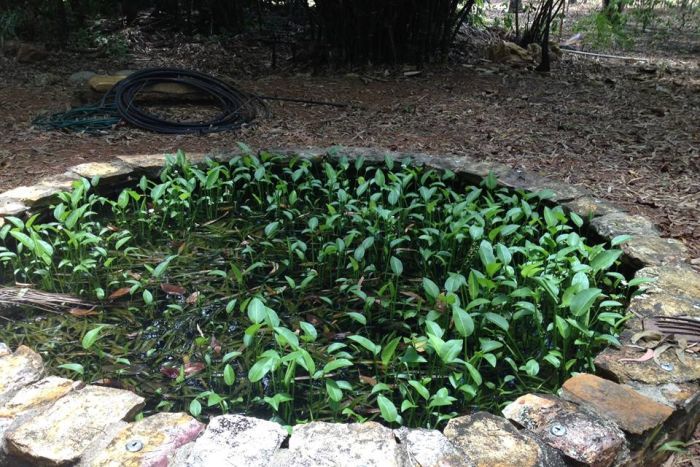NT emergency response team formed to prevent sagittaria weed spreading to Darwin's waterways
Posted
 Photo:
A widespread emergency response team has begun surveying wetlands around Darwin's rural area. (ABC Rural: Courtney Fowler.)
Photo:
A widespread emergency response team has begun surveying wetlands around Darwin's rural area. (ABC Rural: Courtney Fowler.)
The same highly invasive weed mistakenly sold from retail outlets in the Top End two months ago has now been discovered in a backyard pond in Darwin's rural area.
Sagittaria platyphylla is a fast-growing perennial aquatic plant native to North America.
It is considered a threat to waterways and wetlands across Western Australia, but until recently was not previously known to grow in the Territory.
Regional weed management officer Roni Opden said a recall of 28 sagittaria plants mistakenly sold as melon sword by Bunnings in Darwin and Palmerston, and Mitre 10 in Katherine, had led to the identification of the declared weed on a property in Howard Springs.
"As a result of the recall we've had people out checking their backyards. That's led to our very first positive identification of sagittaria in a pond, which is unrelated to the sales," she said.
"At the stage of the recall the plant was in its dormant stage, so it was completely submerged under water and it was very difficult to identify.
"So we gave it few weeks to allow some further growth and that allowed us to positively identity it as this particular sagittaria species."
Plant traced back to another property
Ms Opden said her team believed the plant was about 10 years old and had been traced back to another property in the area.
She said the discovery had prompted a widespread emergency response surveying Darwin's rural area to ensure the highly invasive weed had not spread to nearby wetlands.
"We've already visited that property, we've surveyed it, inspected the nearby surroundings and there's no sign of it pre-existing," Ms Opden said.
"We've been able to narrow down our search focus now, so we've got officers at McMinns Lagoon and Girraween Lagoon.
"In the next week to 10 days we will have an intensive crew of staff who are being trained to identify sagittaria, and they are going to be looking at drainage lines, creeks, waterways, billabongs and ponds.
"We're also doing an intense mail-out survey to people in the nearby vicinity seeking their assistance to check any ponds."
 Photo:
The declared weed sagittaria has been found thriving in this pond in Darwin's rural area. (Supplied: Weed management branch)
Photo:
The declared weed sagittaria has been found thriving in this pond in Darwin's rural area. (Supplied: Weed management branch)
Ms Opden said the weed management branch was also seeking assistance to recover the 13 remaining sagittaria plants that were yet to be accounted for after they were accidentally sold by retailers between August 12 and September 9.
"The recall continues. If you have bought a plant in the last few months from Bunnings that was labelled as melon sword, or an aquatic plant, you need to jump on our website, give us a call and we will come out to to help identify it," she said.
"We want those last 13 plants back, even if they have been put in a pond by now. We will help to remove them and we will continue to survey and monitor any ponds where we've found it."
Previously a Class C (not to be introduced into the NT) weed, it has recently been added to the Class A (to be eradicated) list of weeds in the Northern Territory.
Plant has potential to severely impact waterways
Ms Opden reminded members of the public it was illegal to knowingly cultivate or sell sagittaria in the Northern Territory.
"Sagittaria is a highly invasive aquatic plant that can live in or around water," she said.
"Severe infestations can restrict flows in wetlands and natural waterways, adversely affecting biodiversity and impacting on recreational activities.
"Since detection, sagittaria has shown it is well suited to the Top End climate, indicating that it may prove to be highly invasive and difficult to control if allowed to escape into the Territory's environment."
Ms Opden said the possibility of spread by birds and rain meant the risk of establishment was high.
Possible sightings can be reported to 8999 4567.
Topics: weeds, conservation, howard-springs-0835








